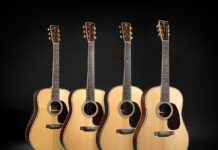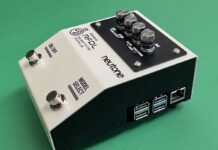Top 10 Essential Vintage Rockabilly Guitar Solos
This past January (during the 2017 Winter NAMM Show), I walked out of the Observatory—a concert venue in Santa Ana, California—and grabbed an Uber to my hotel in Anaheim. As soon as we left the curb, the driver—a young guitar-playing greaser with plenty of tattoos—asked me about the show I’d just seen.
“It was all rockabilly,” I said. “Jeff Beck and Darrel Higham just covered a bunch of Gene Vincent songs at a Gretsch event. Cousin Harley and Duane Eddy played too.”
“Ah, cool,” the driver said. “I love rockabilly.”
I figured he’d say that…you know, based on his greased-back hair and Sailor Jerry ink—despite that very wise saying about not judging a book by its cover.
But when I asked him what rockabilly bands he listened to, it was ASAP obvious that he really didn’t know what rockabilly was—even though he had adopted “the look,” a common practice in Orange County. He might’ve mentioned Johnny Cash at one point, but as soon as he listed some baseball-cap-wearin’ modern country dudes, I cut him off and filled the rest of our trip with a verbal version of what you’re about to read.
Simply put, it’s a guide to rockabilly guitar; to be more precise, it’s a list of 10 killer vintage rockabilly songs that every rock fan—let alone every guitarist—should know and/or learn how to play. These are the songs modern players like Pigat, Smith, Higham, Jim Heath, Buzz Campbell, Brian Setzer and Australia’s Firebird Trio listened to back in the day—not to mention Jimmy Page, George Harrison and Jeff Beck.
Nothing has changed; listening to these songs now—and learning the solos note for note—is just as helpful as it was when Setzer’s pompadour was a foot tall.
Rockabilly is an early form of rock that dates to the mid-Fifties. Wikipedia hits the nail on the head here: “It blends Western musical styles such as country with that of rhythm and blues … Some have also described it as a blend of bluegrass with rock and roll.” I’ve always described it as horn-free (I will not waver on that), hard-driving early rock with a rural accent, delivered with a beat so heavy and deep that you think your head’s gonna explode.
If you need a history lesson, head here. If not, let’s get to the tunes.
Two comrades—TK Smith and Paul Pigat—graciously added their two cents (more like $5.67!) to this list. Smith, a master player and respected guitar builder (he’s the man behind the Smith Special), was a fleet-fingered founding member of rockabilly bigwigs Big Sandy & the Fly-Rite Trio in the early Nineties. Pigat, the Gretsch Guitars-endorsing gent behind Canada’s Cousin Harley, is simply one of the finest rockabilly players within a 134.6666667-mile radius of wherever he might be standing, not to mention a mean country blueser and bebop jazzer. Enjoy!
RACE WITH THE DEVIL
Gene Vincent and His Blue Caps (1956)
Guitarist: Cliff Gallup
“This basically says all there needs to be said about the Cliff Gallup style, which has influenced everyone, whether they know it or not,” Pigat says. Gallup—who was 26 when he joined up with Vincent, one of rock’s great early heroes—was one of the most adept, versatile and influential electric guitarists of his generation. You can find two Guitar World lessons dedicated to Gallup’s ahead-of-his-time flash here and here. We’ve also supplied a handy little “Race with the Devil” lesson.
LONESOME TRAIN (ON A LONESOME TRACK)
The Johnny Burnette Trio (1957)
Guitarist: Grady Martin
“To me this is a perfect guitar solo,” Smith says. “Great guitar tone, too. I spent a good part of the Eighties chasing this tone. At that time, I was under the impression it was done with a Fender bridge pickup. I tried dozens of amps back then with my Tele with no luck. It wasn’t until later that I found out it was Grady with a Bigsby pickup.” For more about Grady Martin (who also plays on Marty Robbins’ “El Paso”), head here.
DUCKTAIL
Joe Clay (1956)
Guitarist: Hal Harris
“I still remember hearing this for the first time,” Smith says. “Hal Harris’ use of the dominant 7th in the bass while he Travis picks, to me, is the quintessential rockabilly sound.” Be sure to read up on Harris right here.
CRAZY LEGS
Gene Vincent and His Blue Caps (1957)
Guitarist: Cliff Gallup
“This is a great song to learn note for note,” Smith says. “I still use some of these licks today.” For this one, we’ve included the original version and a recent performance by Jeff Beck and Darrel Higham. By the way, “Crazy Legs” was written by Jerry Reed (By the way, here’s your very own Jerry Reed guitar lesson).
I’M COMING HOME
Johnny Horton (1957)
Guitarist: Grady Martin
“Anything by Grady Martin is essential to a well-rounded rockabilly guitar player’s arsenal,” Pigat says. “He’s truly a cornerstone of guitar history.” For your viewing pleasure, we’ve included a 2016 live performance of the tune by the Subway Cowboys.
HOW COME IT
“Thumper” Jones (1956)
Guitarist: Hal Harris
“Somewhat crude—but great feeling on this one,” Smith says. Thumper’s voice might sound familiar to country music fans; he is, in fact, a very young version of country music legend George Jones. “How Come It” appeared as the B-side of “Rock It” in the spring of 1956.
MYSTERY TRAIN
Elvis Presley (1955)
Guitarist: Scotty Moore
“I think all young players should lock themselves in their rooms until they can cleanly play Scotty Moore’s lick on this tune,” Smith says. “Learn it slow at first and get it right. I hear a lot of people play it sloppy.” To help you get started, we’ve included a live performance by Scotty Moore and Eric Clapton, plus the internet’s most popular “Mystery Train” lesson video (If you don’t like this lesson, there are plenty more to choose from on YouTube; some even have tab).
SUN MEDLEY
Danny Gatton (1992/1993)
Guitarist: Danny Gatton
Although this list is supposed to be an homage to rockabilly guitarists from the Fifties, this Danny Gatton track from the early Nineties accomplishes the same goal. It finds Gatton blazing through a medley of songs originally recorded by Elvis Presley and Scotty Moore in the Fifties—the songs he listened to as a kid.
For this list, “it’s a tie between Gatton’s ‘Sun Medley’ and the original recordings of the same tunes by Elvis and Scotty,” Pigat says. “It’s undeniable that Scotty Moore changed the world with his playing. It’s also undeniable that Danny Gatton did the same.” Below, you can check out live and studio versions of the song.
BE-BOP-A-LULA
Gene Vincent and His Blue Caps (1956)
Guitarist: Cliff Gallup
What’s this? A third song by Vincent and Gallup? Yes! I have a personal connection to this song; it represents my introduction to rockabilly—although I admit I knew John Lennon’s mid-Seventies version before I knew Gene Vincent’s version. Simply put, if you can play this solo correctly (and nail the tone), you’re officially “playing rockabilly.” It’s a fine introduction to Gallup and to the genre—and it always makes me happy when I play it.
We’ve included an interesting live version by Tom Jones and Nigel Tufnel—I mean Jeff Beck! Please try your best to ignore the horns, which simply do not belong there. Don’t get me started on horns…
TWENTY FLIGHT ROCK
Eddie Cochran (1957)
Guitarist: Eddie Cochran
Leaving Eddie Cochran off this list would be like leaving Doc Watson off a list of influential bluegrass pickers; his music and look had a huge influence on scores of later musicians, including Brian Setzer and Paul McCartney. His “Twenty Flight Rock” guitar solo, a lovable mish-mash of pull-offs, captures the frenzy of rockabilly. For the lesson video, we’ve included a guide to Setzer’s juiced-up version of the song, which leads us into a different era—and our bonus 11th song.
STRAY CAT STRUT
Stray Cats (1981)
Guitarist: Brian Setzer
When I joined a swing/jump-blues band in 2009, I discovered—based on all the jazzy new chord progressions I was learning—that “Stray Cat Strut” isn’t rockabilly at all. Pigat agrees: “Although not technically a rockabilly tune—it’s probably closer to a swing—this tune single-handedly resurrected the genre in the Eighties. There were other great artists at the time, but no single song did as much for the music as this one, and it’s a hell of a guitar solo.”
In 2014, Setzer actually included it on his own list of “The 5 Best Guitar Solos Ever!” on esquire.com. “This might sound bigheaded of me,” Setzer says in the article. “I thought that up when I was 19 years old. And people still come up to me who play guitar and ask me how I play it. It’s lasted a long time.”
A FINAL NOTE: Please remember this list isn’t meant to be complete; that would be impossible and pointless. Regardless, I hope you get some use out of it. Actually, let me leave you with one more clip—”Crazy Eyes Baby” by Australia’s Firebird Trio. It’s an example of how fun, exciting and brain-melting modern rockabilly can be when it’s in the right hands. Below that, check out Buzz Campbell at the 2010 NAMM Show. Nice solo!
Source: www.guitarworld.com







